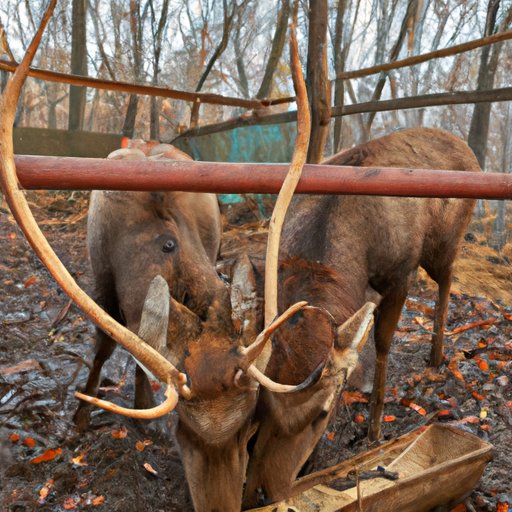Introduction
It’s no secret that deer are known to travel long distances in search of food. But just how far will they go? Understanding deer’s feeding habits and movement can help property owners deal with deer issues and protect their crops. In this article, we’ll explore how researchers study deer movement and feeding habits, how far deer will travel for food, and how hunting and different habitats affect their behavior.
The Distance They’ll Go: Investigating Deer’s Search for Food
Researchers use GPS tracking, radio collars, and other methods to study deer movement and feeding habits. By using this technology, they can better understand how far deer travel for food and what motivates them to move such long distances.
Deer are motivated to travel long distances for food because they need a variety of nutrients throughout the year. In the winter, when food is scarce, deer will travel farther distances to find resources. During the summer, they will typically stick closer to their home range since food is more abundant.
Hunger on the Move: How Far Will Deer Travel for Food?
Deer have been known to travel up to 20 miles round trip in one day to find food. But how far they’ll travel for food depends on several factors, such as the availability of resources and the season. In areas with abundant food resources, deer may only need to travel short distances. In areas with limited resources, they may travel several miles in search of food.
For example, in heavily agricultural areas, deer may travel long distances to reach fields of crops. In more forested areas, they may travel to find new browse species or other food sources that are more abundant. During the winter months, when food is scarce, deer may travel even farther distances from their home range to find resources.
The Great Migration: Understanding Deer’s Food Scavenging Habits
Deer are known to migrate in response to changing food availability. They may move from their summer range to their winter range to find better food sources. During this migration, deer will typically travel along the same routes year after year.
Deer rely on a variety of food sources throughout the year, including leaves, bark, and twigs from trees and shrubs, as well as acorns, fruits, and grasses. Their diet will vary depending on the season and what’s available in their habitat.
Hunting for Food: What Distance Are Deer Willing to Travel?
Hunting can have a significant impact on deer movement and feeding habits. In areas with high hunting pressure, deer may travel farther distances and change their behavior to avoid hunters. In areas with low hunting pressure, deer may be less cautious and stick closer to their home range.
Deer will also change their feeding habits in response to hunting pressure. In areas with high hunting pressure, they may avoid open fields and stick to areas with dense cover. In areas with low hunting pressure, they may be more willing to venture into open fields to feed.
From Fields to Forests: Tracing the Routes Deer Take for Food
Deer will typically have a set travel route that they use to move between their feeding and bedding areas. By understanding these routes, property owners can better manage deer issues.
Deer will often use edges, such as the edge of a field or a forest, as travel routes. They will also use natural travel corridors, such as a stream or ridge. By planting food plots, property owners can create an attractive food source that will help keep deer away from crops. By using deterrents, such as scare tactics or fencing, property owners can discourage deer from traveling along certain routes.
The Science of Survival: Examining How Far Deer Travel for Food
Deer’s survival is closely linked to their ability to find food and travel long distances. Changes in habitat and human activity can have a significant impact on deer movement and feeding habits.
As more land is developed, deer have less area to roam and fewer food sources available to them. This can force them to travel longer distances to find resources, which can put them at risk of being hit by cars or hunted.
Driven by Hunger: The Incredible Journeys of Deer in Search of Food
Understanding deer behavior and movement is critical for property owners looking to manage deer issues. By planting food plots or using deterrents, property owners can help keep deer away from crops and protect their property. By understanding how far deer will travel for food, we can better appreciate the incredible journeys these animals make in search of resources.
Whether you’re a hunter, property owner, or just interested in wildlife, understanding deer’s feeding habits and movement can help you appreciate these incredible animals for what they are.
Conclusion
Deer are driven by hunger and will travel long distances to find food. By understanding their feeding habits and movement, property owners can better manage deer issues on their property. Whether you’re planting food plots, using deterrents, or just enjoying the sight of deer from afar, it’s important to appreciate these incredible animals for what they are. So get out there, learn more about deer behavior, and share your experiences with others.
(Note: Is this article not meeting your expectations? Do you have knowledge or insights to share? Unlock new opportunities and expand your reach by joining our authors team. Click Registration to join us and share your expertise with our readers.)
